Governance Recommendations
Recommendations help kickstart your journey with governance. Essentially, Harness run certain policies behind the scenes to generate recommendations for your governance-enabled AWS accounts. These policies not only help to cut costs but also increase the efficiency of your system. On the Governance Overview page, Harness showcases recommendations that will benefit you to save costs on associated resources. You can click on any recommendation to view its details.
Recommendations By Harness
Cloud Asset Governance provides valuable recommendations, but when it comes to operationalizing them at scale, it might become challenging. Additionally, when using shared cloud accounts across teams, project-level recommendations might not work out. With Granular Recommendations, Governance recommendations will now be generated at the individual resource level, ensuring greater granularity and actionable insights for both custom and out-of-the-box (OOTB) recommendations. This enhancement simplifies implementation and tracking, allowing customers to take more effective action on governance recommendations at scale.
- AWS
- GCP
- Azure
Recommendation: delete-unattached-aws-ebs
Description: Delete all ebs volumes which are unattached
Policy Used:
policies:
- name: delete-unattached-aws-ebs
resource: ebs
filters:
- Attachments: []
- State: available
actions:
- delete
Savings Computed: The policy identifies a list of resources on which potential savings are calculated by summing up cost of each resource for last 30 days.
Permissions Required:
- Dry Run:
ec2:DetachVolumeec2:DescribeVolumes
- Run Once:
ec2:DetachVolumeec2:DeleteVolumeec2:DescribeVolumes
Recommendation: list-low-request-count-aws-elb
Description: List ELBs with low request count
Policy Used:
policies:
- name: list-low-request-count-aws-elb
resource: elb
description: List ELBs with low request count
filters:
- type: metrics
name: RequestCount
statistics: Sum
days: 7
value: 7
missing-value: 0
op: less-than
Savings Computed: The policy identifies a list of resources on which potential savings are calculated by summing up cost of each resource for last 30 days.
Permissions Required:
-
Dry Run:
cloudwatch:GetMetricDataelasticloadbalancing:DescribeLoadBalancers
-
Run Once:
cloudwatch:GetMetricDataelasticloadbalancing:DescribeLoadBalancers
Recommendation: migrate-gp2-to-gp3-aws-ebs
Description: Migrate gp2 volumes to gp3
Policy Used:
policies:
- name: migrate-gp2-to-gp3-aws-ebs
resource: ebs
filters:
- VolumeType: gp2
- modifyable
actions:
- type: modify
volume-type: gp3
Savings Computed: The policy identifies a list of resources on which potential savings are calculated by summing up cost of each resource for last 30 days. Then, 20% of that sum is taken as the savings.
Permissions Required:
- Dry Run:
ec2:DescribeVolumeAttributeec2:DescribeVolumesModifications
- Run Once:
ec2:DescribeVolumeAttributeec2:ModifyVolumeAttributeec2:DescribeVolumesModifications
Recommendation: delete-volume-absent-aws-ebs-snapshot
Description: Delete snapshots with no volumes
Policy Used:
policies:
- name: delete-volume-absent-aws-ebs-snapshot
description: Find any snapshots that do not have a corresponding volume.
resource: aws.ebs-snapshot
filters:
- type: volume
key: VolumeId
value: absent
actions:
- delete
Savings Computed: The policy identifies a list of resources on which potential savings are calculated by summing up cost of each resource for last 30 days.
Permissions Required:
- Dry Run:
ec2:DescribeVolumes
- Run Once:
ec2:DescribeVolumesec2:DeleteSnapshot
Recommendation: stop-unused-aws-rds
Description: Stop unused RDS database
Policy Used:
policies:
- name: stop-unused-aws-rds
resource: rds
description: Stop unused RDS database
filters:
- type: value
key: DBInstanceStatus
value: available
- type: metrics
name: DatabaseConnections
statistics: Sum
days: 7
value: 0
op: equal
actions:
- stop
Savings Computed: The policy identifies a list of resources on which potential savings are calculated by summing up cost of each resource for last 30 days.
Permissions Required:
- Dry Run:
rds:DescribeDBInstances
- Run Once:
rds:DescribeDBInstancesrds:StopDBInstance
Recommendation: delete-unused-aws-elb
Description: Delete unused ELB
Policy Used:
policies:
- name: delete-unused-aws-elb
resource: elb
filters:
- Instances: []
actions:
- delete
Savings Computed: The policy identifies a list of resources on which potential savings are calculated by summing up cost of each resource for last 30 days.
Permissions Required:
- Dry Run:
elasticloadbalancing:DescribeLoadBalancers
- Run Once:
elasticloadbalancing:DescribeLoadBalancerselasticloadbalancing:DeleteLoadBalancer
Recommendation: release-unattached-aws-elastic-ip
Description: Release unattached Elastic IPs
Policy Used:
policies:
- name: release-unattached-aws-elastic-ip
resource: aws.elastic-ip
filters:
- AssociationId: absent
actions:
- release
Savings Computed: The policy identifies a list of resources on which potential savings are calculated by summing up cost of each resource for last 30 days.
Permissions Required:
- Dry Run:
ec2:DescribeAddresses
- Run Once:
ec2:DescribeAddressesec2:ReleaseAddress
Recommendation: delete-underutilized-aws-cache-cluster
Description: Delete underutilized cache cluster with CPU utilization less than 5% in the last 7 days.
Policy Used:
policies:
- name: delete-underutilized-aws-cache-cluster
resource: cache-cluster
description: |
Delete underutilised cache cluster with CPU utilisation less than 5% in last 7 days
filters:
- type: metrics
name: CPUUtilization
days: 7
period: 86400
value: 5
op: less-than
actions:
- type: delete
skip-snapshot: false
Savings Computed: The policy identifies a list of resources on which potential savings are calculated by summing up the cost of each resource for the last 30 days.
Permissions Required:
- Dry Run:
elasticache:DescribeCacheClusters
- Run Once:
elasticache:DescribeCacheClusterselasticache:DeleteCacheClusterelasticache:DeleteReplicationGroup
Recommendation: configure-lifecycle-aws-s3
Description: Configure lifecycle for S3 buckets wherever it is absent which would help to reduce storage spend
Policy Used:
policies:
- name: configure-lifecycle-aws-s3
resource: aws.s3
description: |
Configure lifecycle for s3 buckets wherever it is absent which would help to reduce storage spend
filters:
- type : value
key : Lifecycle
value : absent
actions:
- type: configure-lifecycle
rules:
- ID: harness-default-lifecycle
Status: Enabled
Filter:
Prefix: ''
Expiration:
ExpiredObjectDeleteMarker: True
AbortIncompleteMultipartUpload:
DaysAfterInitiation: 7
NoncurrentVersionExpiration:
NoncurrentDays: 30
NewerNoncurrentVersions: 6
Savings Computed: To estimate the percentage cost savings from the given S3 lifecycle policies, we need to look at the specific actions and apply some reasonable assumptions. Here's a step-by-step approach:
- Abort Incomplete Multipart Uploads after 7 days:
- Assumption: 5% of all uploads are incomplete and are not cleaned up without this policy.
- Cost Impact: Each incomplete multipart upload that is aborted saves the storage cost of the data uploaded so far.
- Expire Noncurrent Versions after 30 days (keeping 6 versions):
- Assumption: Each object has, on average, 10 noncurrent versions stored. Expiring noncurrent versions after 30 days, keeping only the latest 6, will delete 4 out of every 10 noncurrent versions.
- Cost Impact: Deleting 40% of noncurrent versions reduces the total storage used by these versions.
Example Calculation
Let's assume the following for a single S3 bucket:
Total Storage Used: 1 TB (1,024 GB) in the S3 Standard storage class.
Storage Distribution:
- Current versions: 50% (512 GB)
- Noncurrent versions: 40% (410 GB)
- Incomplete multipart uploads: 10% (102 GB)
Calculations:
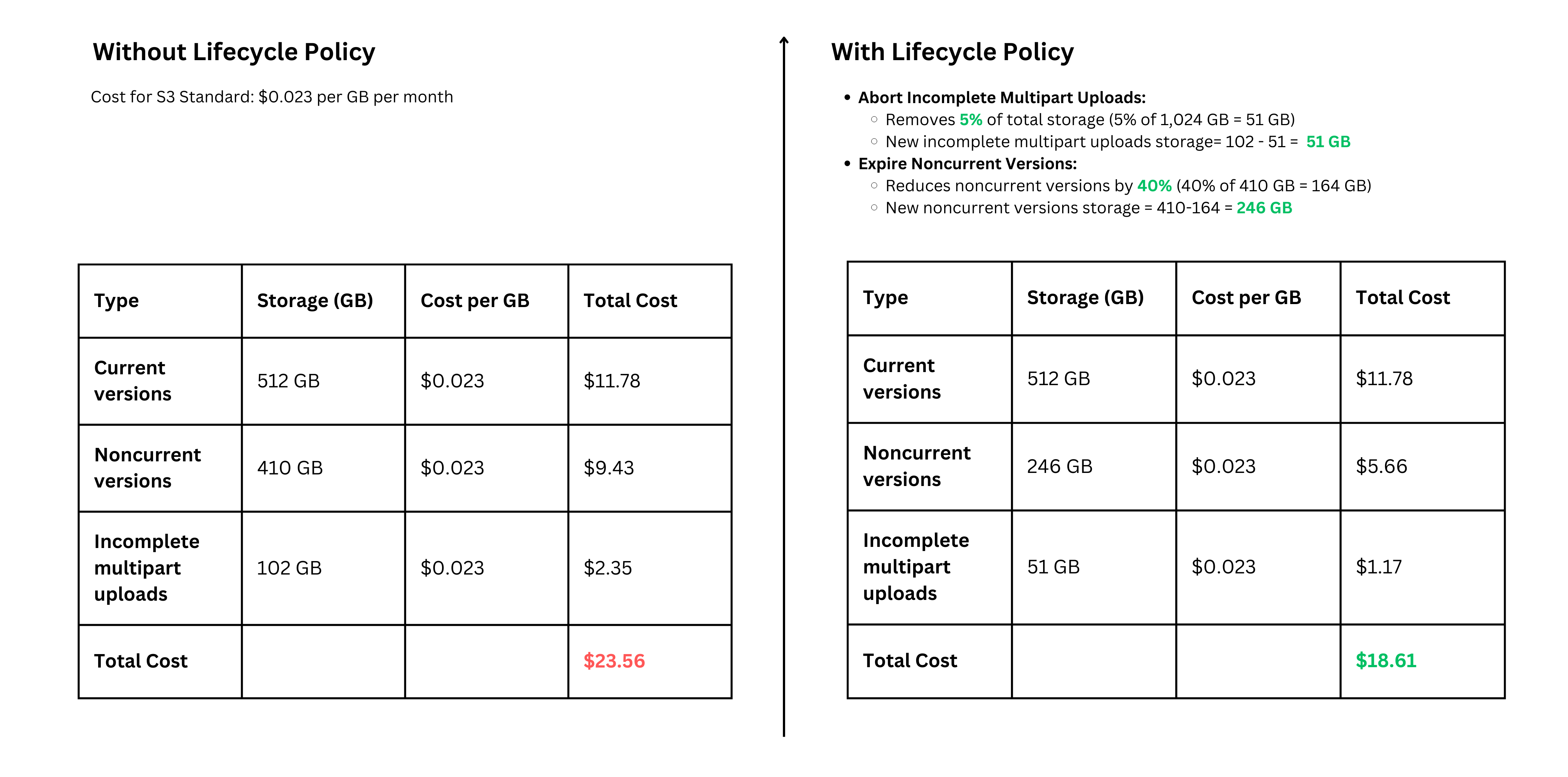
Total Savings
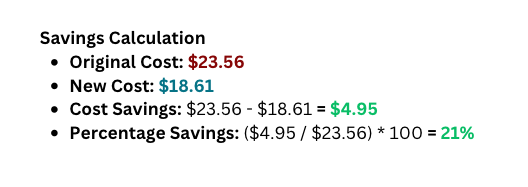
References:
Permissions Required:
- Dry Run:
s3:GetLifecycleConfiguration
- Run Once:
s3:GetLifecycleConfigurations3:PutLifecycleConfiguration
Recommendation: set-intelligent-tiering-aws-s3
Description: Configure intelligent tiering for S3 buckets wherever it is disabled which would help to reduce storage spend.
Policy Used:
policies:
- name: set-intelligent-tiering-aws-s3
resource: aws.s3
description: |
Configure intelligent tiering for s3 buckets wherever it is disabled which would help to reduce storage spend.
filters:
- not:
- type: intelligent-tiering
attrs:
- Status: Enabled
actions:
- type: set-intelligent-tiering
Id: harness-default
IntelligentTieringConfiguration:
Id: harness-default
Status: Enabled
Tierings:
- Days: 90
AccessTier: ARCHIVE_ACCESS
- Days: 180
AccessTier: DEEP_ARCHIVE_ACCESS
Savings Computed:
- Frequent Access Tier: This tier is equivalent in cost to the standard S3 storage, so no savings here.
- Infrequent Access Tier: Data not accessed for 30 days moves here, saving approximately 45% compared to standard S3 storage.
- Archive Instant Access Tier: Data not accessed for 90 days moves here, with savings of up to 68% compared to standard storage.
- Archive Access Tier: If configured, data not accessed for 90 days can move here, offering around 71% savings.
- Deep Archive Access Tier: Data not accessed for 180 days can be moved to this tier, providing up to 95% savings.
Example Calculation
Assume you have 1 TB of data stored in S3 standard storage:
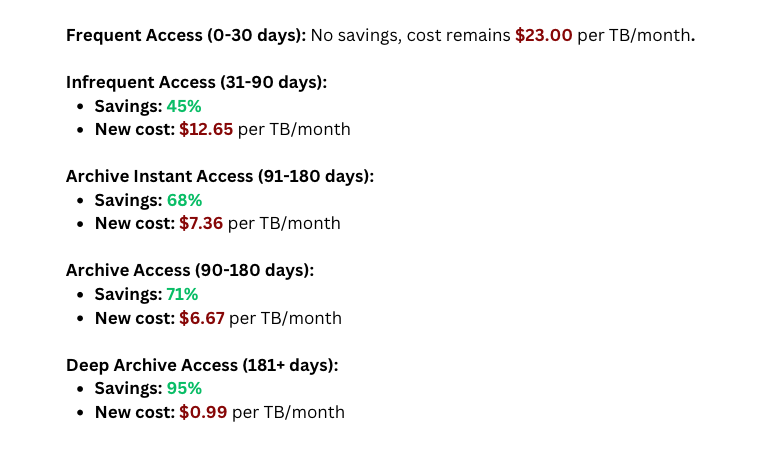
Example Scenario
If 20% of your data transitions to the Infrequent Access tier after 30 days, 20% moves to Archive Access after 90 days, and 10% moves to Deep Archive Access after 180 days, your costs might look like this:
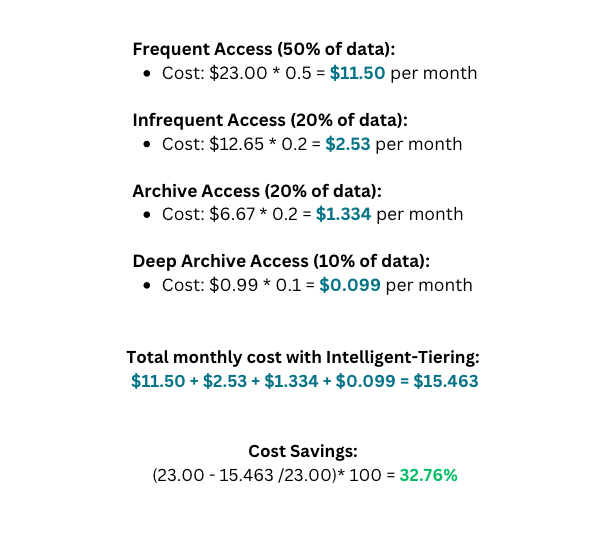
This results in a cost savings of approximately 32.76% compared to keeping all data in standard S3 storage (15.463 per month).
References:
Permissions Required:
- Dry Run:
s3:GetBucketIntelligentTieringConfiguration
- Run Once:
s3:GetBucketIntelligentTieringConfigurations3:PutIntelligentTieringConfiguration
Recommendation: delete-underutilized-aws-redshift
Description: Delete any Amazon Redshift cluster where CPU Utilization has been less than 5% for the last 7 days
Policy Used:
policies:
- name: delete-underutilized-aws-redshift
resource: redshift
description: |
Delete redshift cluster where CPU Utilization is less than 5% for last 7 days
filters:
- type: metrics
name: CPUUtilization
days: 7
period: 86400
value: 5
op: less-than
actions:
- delete
Savings Computed: The policy identifies a list of resources on which potential savings are calculated by summing up the cost of each resource for the last 30 days.
Permissions Required:
- Dry Run:
redshift:DescribeClusters
- Run Once:
redshift:DescribeClustersredshift:DeleteCluster
Recommendation: delete-old-manual-aws-redshift-snapshot
Description: Delete all redshift snapshots older than 35 days with a lifetime retention period
Policy Used:
policies:
- name: delete-old-manual-aws-redshift-snapshot
resource: redshift-snapshot
description: |
Delete all redshift snapshot older than 35 days with lifetime retention period
filters:
- "ManualSnapshotRetentionPeriod": -1
- type: age
days: 35
op: gt
actions:
- delete
Savings Computed: The policy identifies a list of resources on which potential savings are calculated by summing up the cost of each resource for the last 30 days.
Permissions Required:
- Dry Run:
redshift:DescribeClusterSnapshots
- Run Once:
redshift:DeleteClusterSnapshotredshift:DescribeClusterSnapshots
Recommendation: delete-empty-aws-dynamodb-table
Description: Delete DyanmoDB tables which are empty
Policy Used:
policies:
- name: delete-empty-aws-dynamodb-table
resource: dynamodb-table
description: |
Delete DyanmoDB tables which are empty
filters:
- TableSizeBytes: 0
actions:
- delete
Savings Computed: The policy identifies a list of resources on which potential savings are calculated by summing up the cost of each resource for the last 30 days.
Recommendation: delete-stale-aws-log-group
Description: Delete stale cloud watch log groups
Policy Used:
policies:
- name: delete-stale-aws-log-group
resource: log-group
description: |
Delete stale cloud watch log groups
filters:
- type: last-write
days: 60
actions:
- delete
Savings Computed: The policy identifies a list of resources on which potential savings are calculated by summing up the cost of each resource for the last 30 days.
Recommendation: delete-stale-aws-rds-snapshot
Description: Delete all stale(older than 28 days) RDS snapshots
Policy Used:
policies:
- name: delete-stale-aws-rds-snapshot
resource: rds-snapshot
description: |
Delete all stale(older than 28 days) RDS snapshots
filters:
- type: age
days: 28
op: ge
actions:
- delete
Savings Computed: The policy identifies a list of resources on which potential savings are calculated by summing up the cost of each resource for the last 30 days.
Recommendation: delete-unencrypted-aws-firehose
Description: Delete Firehose which are not encrypted
Policy Used:
policies:
- name: delete-unencrypted-aws-firehose
resource: firehose
description: |
Delete Firehose which are not encrypted
filters:
- KmsMasterKeyId: absent
actions:
- type: delete
Savings Computed: The policy identifies a list of resources on which potential savings are calculated by summing up the cost of each resource for the last 30 days.
Recommendation: delete-unencrypted-aws-sqs
Description: Delete SQS which are not encrypted
Policy Used:
policies:
- name: delete-unencrypted-aws-sqs
resource: sqs
description: |
Delete SQS which are not encrypted
filters:
- KmsMasterKeyId: absent
actions:
- type: delete
Savings Computed: The policy identifies a list of resources on which potential savings are calculated by summing up the cost of each resource for the last 30 days.
Recommendation: delete-unused-aws-nat-gateway
Description: Delete unused NAT Gateways based on no associated traffic in past 7 days.
Policy Used:
policies:
- name: delete-unused-aws-nat-gateway
resource: nat-gateway
description: |
Delete unused NAT Gateways based on no associated traffic in past 7 days.
filters:
- type: metrics
name: BytesOutToDestination
statistics: Sum
period: 86400
days: 7
value: 0
op: eq
actions:
- type: delete
Savings Computed: The policy identifies a list of resources on which potential savings are calculated by summing up the cost of each resource for the last 30 days.
Recommendation: delete-idle-gcp-image
Description: Delete GCP recommended idle images
Policy Used:
policies:
- name: delete-idle-gcp-image
description: |
Delete GCP images which are not used to create a disk for at least 15 days and not used in any instance template.
These idle images are fetched from GCP recommender.
resource: gcp.image
filters:
- type: recommend
id: google.compute.image.IdleResourceRecommender
actions:
- type: delete
Savings Computed: The policy identifies a list of resources on which potential savings are calculated by summing up cost of each resource for last 30 days.
Permissions Required:
- Dry Run:
recommender.computeImageIdleResourceRecommendations.list - Run Once:
recommender.computeImageIdleResourceRecommendations.listcompute.images.delete
Recommendation: delete-never-attached-gcp-disk
Description: Delete GCP recommended idle persistent disks which were never attached to a VM and is blank
Policy Used:
policies:
- name: delete-never-attached-gcp-disk
description: |
Delete GCP disks which are created at least 15 days ago and never attached to a VM and is blank.
These idle disks are fetched from GCP recommender.
resource: gcp.disk
filters:
- type: recommend
id: google.compute.disk.IdleResourceRecommender
- type: value
key: lastAttachTimestamp
value:
op: eq
actions:
- type: delete
Savings Computed: The policy identifies a list of resources on which potential savings are calculated by summing up cost of each resource for last 30 days.
Permissions Required:
- Dry Run:
recommender.computeDiskIdleResourceRecommendations.list - Run Once:
recommender.computeDiskIdleResourceRecommendations.listcompute.disks.delete
Recommendation: stop-forever-running-gcp-instance
Description: Stop the gcp instances that have an uptime greater than 30 days.
Policy Used:
policies:
- name: stop-forever-running-gcp-instance
description: |
Stop the gcp instances that have an uptime greater than 30 days.
resource: gcp.instance
filters:
- type: metrics
name: compute.googleapis.com/instance/uptime_total
aligner: ALIGN_NONE
value: 2592000
op: greater-than
- type: value
key: status
value: "RUNNING"
op: eq
actions:
- type: stop
Savings Computed: The policy identifies a list of resources on which potential savings are calculated by summing up cost of each resource for last 30 days.
Permissions Required:
-
Dry Run:
compute.instances.listmonitoring.timeSeries.list
-
Run Once:
compute.instances.listmonitoring.timeSeries.listcompute.instances.stop
Recommendation: delete-old-gcp-snapshot
Description: Delete gcp snapshots older than 14 days.
Policy Used:
policies:
- name: delete-old-gcp-snapshot
resource: gcp.snapshot
description: |
Delete gcp snapshots older than 14 days.
filters:
- type: value
key: creationTimestamp
op: greater-than
value_type: age
value: 14
actions:
type: delete
Savings Computed: The policy identifies a list of resources on which potential savings are calculated by summing up cost of each resource for last 30 days.
Permissions Required:
-
Dry Run:
compute.snapshots.list
-
Run Once:
compute.snapshots.listcompute.snapshots.delete
Recommendation: stop-underutilized-gcp-instance
Description: Stop underutilised instances with average CPU utilisation less than 5% in last 3 days.
Policy Used:
policies:
- name: stop-underutilized-gcp-instance
resource: gcp.instance
description: Stop underutilised instances with average CPU utilisation less than 5% in last 3 days
filters:
- type: metrics
name: compute.googleapis.com/instance/cpu/utilization
aligner: ALIGN_MEAN
days: 3
value: 5
op: less-than
- type: value
key: status
value: "RUNNING"
op: eq
actions:
- type: stop
Savings Computed: The policy identifies a list of resources on which potential savings are calculated by summing up cost of each resource for last 30 days.
Permissions Required:
-
Dry Run:
compute.instances.listmonitoring.timeSeries.list
-
Run Once:
compute.instances.listmonitoring.timeSeries.listcompute.instances.stop
Recommendation: stop-underutilized-gcp-sql-instance
Description: Stop underutilised sql instances with average CPU utilisation less than 5% in last 3 days
Policy Used:
policies:
- name: stop-underutilized-gcp-sql-instance
resource: gcp.sql-instance
description: |
Stop underutilised sql instances with average CPU utilisation less than 5% in last 3 days
filters:
- type: metrics
name: cloudsql.googleapis.com/database/cpu/utilization
aligner: ALIGN_MEAN
days: 3
value: 5
op: less-than
actions:
- type: stop
Savings Computed: The policy identifies a list of resources on which potential savings are calculated by summing up cost of each resource for last 30 days.
Permissions Required:
-
Dry Run:
cloudsql.instances.listmonitoring.timeSeries.list
-
Run Once:
cloudsql.instances.listmonitoring.timeSeries.listcloudsql.instances.update
Recommendation: snapshot-and-delete-unattached-gcp-disk
Description: Snapshot and delete GCP recommended idle persistent disks which are unattached
Policy Used:
policies:
- name: snapshot-and-delete-unattached-gcp-disk
description: |
Snapshot and delete GCP disks which are detached for at least 15 days.
These idle disks are fetched from GCP recommender.
resource: gcp.disk
filters:
- type: recommend
id: google.compute.disk.IdleResourceRecommender
- type: value
key: lastAttachTimestamp
value:
op: ne
actions:
- type: snapshot
name_format: "{disk[name]:.50}-{now:%Y-%m-%d}"
- type: delete
Savings Computed: Savings are considered as 35% of the total cost. Implementing this recommendation would result in 35% to 92% reduction in the maintenance cost of that disk. Thus, we have considered the minimum savings achievable, which is 35%. Ref: https://cloud.google.com/compute/docs/viewing-and-applying-idle-resources-recommendations
Permissions Required:
-
Dry Run:
recommender.computeDiskIdleResourceRecommendations.list
-
Run Once:
recommender.computeDiskIdleResourceRecommendations.listcompute.disks.delete
Recommendation: delete-idle-gcp-gke-cluster
Description: List GCP Idle GKE Clusters Recommendations
Policy Used:
policies:
- name: delete-idle-gcp-gke-cluster
description: |
List GCP Idle GKE Clusters Recommendations
resource: gcp.gke-cluster
filters:
- type: recommend
id: google.container.DiagnosisRecommender
actions:
- type: delete
Savings Computed: The policy identifies a list of resources on which potential savings are calculated by summing up the cost of each resource for the last 30 days.
Permissions Required:
-
Dry Run:
recommender.containerDiagnosisInsights.listcontainer.clusters.list
-
Run Once:
recommender.containerDiagnosisInsights.listcontainer.clusters.listcontainer.clusters.delete
Recommendation: list-cost-recommendations-gcp-cloud-run-service
Description:
Policy Used:
policies:
- name: list-cost-recommendations-gcp-cloud-run-service
resource: gcp.cloud-run-service
description: |
List Cloud Run CPU Allocation Recommendations
filters:
- type: recommend
id: google.run.service.CostRecommender
Savings Computed: The policy identifies a list of resources on which potential savings are calculated by summing up the cost of each resource for the last 30 days.
Permissions Required:
-
Dry Run:
recommender.runServiceCostRecommendations.listrun.services.list
-
Run Once:
recommender.runServiceCostRecommendations.listrun.services.list
Recommendation: list-unused-gcp-bq-dataset
Description: List BigQuery datasets that haven't been accessed in the last 7 days.
Policy Used:
policies:
- name: list-unused-gcp-bq-dataset
resource: gcp.bq-dataset
description: |
List BigQuery datasets that haven't been accessed in the last 7 days.
filters:
- type: value
key: lastModifiedTime
op: less-than
value_type: age
value: 7
Savings Computed: The policy identifies a list of resources on which potential savings are calculated by summing up cost of each resource for the last 30 days.
Permissions Required:
-
Dry Run:
bigquery.datasets.get
-
Run Once:
bigquery.datasets.get
Recommendation: delete-unused-gcp-function
Description: Delete Cloud Functions that haven't been invoked in the last 7 days to reduce costs.
Policy Used:
policies:
- name: delete-unused-gcp-function
resource: gcp.function
description: >
Delete Cloud Functions that haven't been invoked in the last 7 days to
reduce costs.
filters:
- type: metrics
name: cloudfunctions.googleapis.com/function/execution_count
metric-key: resource.labels.function_name
days: 7
value: 0
op: eq
actions:
- type: delete
Savings Computed: The policy identifies a list of resources on which potential savings are calculated by summing up cost of each resource for last 30 days.
Permissions Required:
-
Dry Run:
monitoring.timeSeries.listcloudfunctions.functions.list
-
Run Once:
monitoring.timeSeries.listcloudfunctions.functions.listcloudfunctions.functions.delete
Recommendation: list-under-utilized-gcp-bucket
Description: List low utilized gcp buckets in last 7 days.
Policy Used:
policies:
- name: list-under-utilized-gcp-bucket
description: |
List low utilized gcp buckets in last 7 days.
resource: gcp.bucket
filters:
- type: metrics
name: storage.googleapis.com/network/sent_bytes_count
aligner: ALIGN_COUNT
days: 7
value: 1024
op: less-than
missing-value: 0
- type: metrics
name: storage.googleapis.com/network/received_bytes_count
aligner: ALIGN_COUNT
days: 7
value: 1024
op: less-than
missing-value: 0
Savings Computed: The policy identifies a list of resources on which potential savings are calculated by summing up the cost of each resource for last 30 days.
Permissions Required:
-
Dry Run:
monitoring.timeSeries.liststorage.buckets.list
-
Run Once:
monitoring.timeSeries.liststorage.buckets.list
Recommendation: list-hanged-gcp-dataflow-job
Description: List Dataflow jobs that have been in an hanged state for more than 1 day.
Policy Used:
policies:
- name: list-hanged-gcp-dataflow-job
resource: gcp.dataflow-job
description: List Dataflow jobs that have been in an hanged state for more than 1 day.
filters:
- type: value
key: startTime
op: greater-than
value_type: age
value: 1
- type: value
key: currentState
value:
- JOB_STATE_RUNNING
- JOB_STATE_DRAINING
- JOB_STATE_CANCELLING
Savings Computed: The policy identifies a list of resources on which potential savings are calculated by summing up cost of each resource for last 30 days.
Permissions Required:
-
Dry Run:
dataflow.jobs.list
-
Run Once:
dataflow.jobs.list
Recommendation: delete-under-utilized-gcp-loadbalancer-address
Description: Delete all load balancers with low utilizations, where packet count is less than 1000 in the last 72 hours.
Policy Used:
policies:
- name: delete-under-utilized-gcp-loadbalancer-address
resource: gcp.loadbalancer-address
description: >
Delete all low utilized load balancers where packet count is less than
1000 in last 72 hours
filters:
- type: metrics
name: compute.googleapis.com/instance/network/received_packets_count
metric-key: metric.labels.instance_name
aligner: ALIGN_COUNT
days: 3
value: 1000
op: le
actions:
- type: delete
Savings Computed: The policy identifies a list of resources on which potential savings are calculated by summing up the cost of each resource for the last 30 days.
Permissions Required:
-
Dry Run:
monitoring.timeSeries.listcompute.addresses.list
-
Run Once:
monitoring.timeSeries.listcompute.addresses.listcompute.addresses.delete
Recommendation: list-under-utilized-gcp-redis
Description: List Redis instances with less than 5% CPU utilization over the last 7 days.
Policy Used:
policies:
- name: list-under-utilized-gcp-redis
resource: gcp.redis
description: List Redis instances with less than 5% CPU utilization in last 7 days
filters:
- type: metrics
name: redis.googleapis.com/stats/cpu_utilization
metric-key: resource.labels.instance_id
days: 7
value: 0.05
op: lte
Savings Computed: The policy identifies a list of resources on which potential savings are calculated by summing up cost of each resource for the last 30 days.
Permissions Required:
-
Dry Run:
monitoring.timeSeries.listredis.instances.list
-
Run Once:
monitoring.timeSeries.listredis.instances.list
GCP Resource Coverage (Examples)
- Compute Engine instances
- Cloud Storage buckets
- App Engine applications
- Cloud SQL instances
- Cloud IAM policies
For a comprehensive list of all supported GCP resources, refer to the GCP Resource Reference — Cloud Custodian documentation.
Recommendation: delete-low-utilized-azure-cosmodb
Description: Delete low utilised CosmosDB based on total requests in last 72 hours.
Policy Used:
policies:
- name: delete-low-utilized-azure-cosmodb
resource: azure.cosmosdb
description: |
Delete low utilised CosmosDB based on total requests in last 72 hours
filters:
- type: metric
metric: TotalRequests
op: le
aggregation: total
threshold: 1000
timeframe: 72
actions:
- type: delete
Savings Computed: The policy identifies a list of resources on which potential savings are calculated by summing up cost of each resource for last 30 days.
Permissions Required: To execute the action section of the custodian policy, the Contributor Role is required, whereas the Reader Role suffices for generating recommendations.
Details
Recommendation: delete-unattached-azure-disk
Description: Delete all unattached disks.Policy Used:
policies:
- name: delete-unattached-azure-disk
resource: azure.disk
description: |
Delete all unattached disks
filters:
- type: value
key: properties.diskState
value: Unattached
actions:
- type: delete
Savings Computed: The recommendation identifies a list of resources; to calculate potential savings, the costs of all resources over the last 30 days are summed together and that is shown as the potential savings.
Permissions Required: To execute the action section of the custodian policy, the Contributor Role is required, whereas the Reader Role suffices for generating recommendations.
Details
Recommendation: delete-low-utilized-azure-load-balancer
Description: Delete all low utilised load balancers where packet count is less than 1000 in last 72 hours.Policy Used:
policies:
- name: delete-low-utilized-azure-load-balancer
resource: azure.loadbalancer
description: |
Delete all low utilised load balancers where packet count is less than 1000 in last 72 hours
filters:
- type: metric
metric: PacketCount
op: le
aggregation: total
threshold: 1000
timeframe: 72
actions:
- type: delete
Savings Computed: The policy identifies a list of resources on which potential savings are calculated by summing up cost of each resource for last 30 days.
Permissions Required: To execute the action section of the custodian policy, the Contributor Role is required, whereas the Reader Role suffices for generating recommendations.
Details
Recommendation: delete-orphaned-azure-networkinterface
Description: Delete network interface which are not attached to virtual machine.Policy Used:
policies:
- name: delete-orphaned-azure-networkinterface
resource: azure.networkinterface
description: |
Delete network interface which are not attached to virtual machine
filters:
- type: value
key: properties.virtualMachine
value: null
actions:
- type: delete
Savings Computed: The policy identifies a list of resources on which potential savings are calculated by summing up cost of each resource for last 30 days.
Permissions Required: To execute the action section of the custodian policy, the Contributor Role is required, whereas the Reader Role suffices for generating recommendations.
Details
Recommendation: stop-underutilized-azure-vm
Description: Stop underutilised virtual machines with average CPU utilisation less than 5% in last 72 hours.Policy Used:
policies:
- name: stop-underutilized-azure-vm
resource: azure.vm
description: |
Stop underutilised virtual machines with average CPU utilisation less than 5% in last 72 hours
filters:
- type: metric
metric: Percentage CPU
op: le
aggregation: average
threshold: 5
timeframe: 72
actions:
- type: stop
Savings Computed: The policy identifies a list of resources on which potential savings are calculated by summing up cost of each resource for last 30 days.
Permissions Required: To execute the action section of the custodian policy, the Contributor Role is required, whereas the Reader Role suffices for generating recommendations.
Details
Recommendation: delete-low-utilized-azure-keyvault
Description: Delete KeyVaults with less than 10 API hits in last 72 hours.Policy Used:
policies:
- name: delete-low-utilized-azure-keyvault
resource: azure.keyvault
description: |
Delete KeyVaults with less than 10 API hits in last 72 hours
filters:
- type: metric
metric: ServiceApiHit
aggregation: total
op: lt
threshold: 10
timeframe: 72
actions:
- type: delete
Savings Computed: The policy identifies a list of resources on which potential savings are calculated by summing up cost of each resource for last 30 days.
Permissions Required: To execute the action section of the custodian policy, the Contributor Role is required, whereas the Reader Role suffices for generating recommendations.
Details
Recommendation: delete-low-utilized-azure-sqlserver
Description: Delete SQL servers with less than 10% average DTU consumption over last 72 hours.Policy Used:
policies:
- name: delete-low-utilized-azure-sqlserver
resource: azure.sqlserver
description: |
Delete SQL servers with less than 10% average DTU consumption over last 72 hours
filters:
- type: metric
metric: dtu_consumption_percent
aggregation: average
op: lt
threshold: 10
timeframe: 72
filter: "DatabaseResourceId eq '*'"
actions:
- type: delete
Savings Computed: The policy identifies a list of resources on which potential savings are calculated by summing up cost of each resource for last 30 days.
Permissions Required: To execute the action section of the custodian policy, the Contributor Role is required, whereas the Reader Role suffices for generating recommendations.
Details
Recommendation: delete-unattached-azure-publicip
Description: Delete public ip which are not attached to any network interface.Policy Used:
policies:
- name: delete-unattached-azure-publicip
resource: azure.publicip
description: |
Delete public ip which are not attached to any network interface
filters:
- type: value
key: properties.ipConfiguration
value: null
actions:
- type: delete
Savings Computed: The policy identifies a list of resources on which potential savings are calculated by summing up cost of each resource for last 30 days.
Permissions Required: To execute the action section of the custodian policy, the Contributor Role is required, whereas the Reader Role suffices for generating recommendations.
Details
Recommendation: delete-low-utilized-azure-datalake
Description: Delete all Datalake Stores with less than 1000 read requests or 1000 write requests in the last 72 hours.Policy Used:
policies:
- name: delete-low-utilized-azure-datalake
resource: azure.datalake
description: |
Delete all Datalake Stores with less than 1000 read requests or 1000 write requests in the last 72 hours
filters:
- or:
- type: metric
metric: ReadRequests
op: le
aggregation: total
threshold: 1000
timeframe: 72
- type: metric
metric: WriteRequests
op: le
aggregation: total
threshold: 100
timeframe: 72
actions:
- type: delete
Savings Computed: The policy identifies a list of resources on which potential savings are calculated by summing up cost of each resource for last 30 days.
Permissions Required: To execute the action section of the custodian policy, the Contributor Role is required, whereas the Reader Role suffices for generating recommendations.
Details
Recommendation: delete-unused-azure-postgresql-server
Description: Delete PostgreSQL Servers that have had zero active connections in the last 72 hours.Policy Used:
policies:
- name: delete-unused-azure-postgresql-server
resource: azure.postgresql-server
description: |
Delete PostgreSQL Servers that have had zero active connections in the last 72 hours
filters:
- type: metric
metric: active_connections
op: eq
threshold: 0
timeframe: 72
actions:
- type: delete
Savings Computed: The policy identifies a list of resources on which potential savings are calculated by summing up cost of each resource for last 30 days.
Permissions Required: To execute the action section of the custodian policy, the Contributor Role is required, whereas the Reader Role suffices for generating recommendations.
Details
Recommendation: delete-orphaned-azure-appserviceplan
Description: Delete orphaned(numberOfSites=0) application service planPolicy Used:
policies:
- name: delete-orphaned-azure-appserviceplan
resource: azure.appserviceplan
description: |
Delete orphaned(numberOfSites=0) application service plan
filters:
- type: value
key: properties.numberOfSites
op: eq
value: 0
actions:
- delete
Savings Computed: The recommendation identifies a list of resources; to calculate potential savings, the costs of all resources over the last 30 days are summed together and that is shown as the potential savings.
Permissions Required: To execute the action section of the custodian policy, the Contributor Role is required, whereas the Reader Role suffices for generating recommendations.
Rules Generating Recommendations
The "Rules Generating Recommendations" tab shows all the rules you’ve turned on to generate recommendations. Every day, our system runs these rules across your main accounts and regions. The results are shown as recommendations, so you can track their full lifecycle from when they’re created to when they’re addressed. The tab also gives you insights into the rules you’ve enabled. You can see a breakdown by account and region, including whether the rule ran successfully, had an error, or found resources that don’t have any savings attached.
Using Rules Generating Recommendations
- Navigate to the Rules Generating Recommendations > +New Rule to begin the process
- Select a governance rule to generate recommendations
- Configure the rule's scope:
- All Accounts: Apply the rule across your entire cloud infrastructure
- Specific Accounts: Target only selected cloud accounts for evaluation
- Click Generate Recommendations to initiate the evaluation process
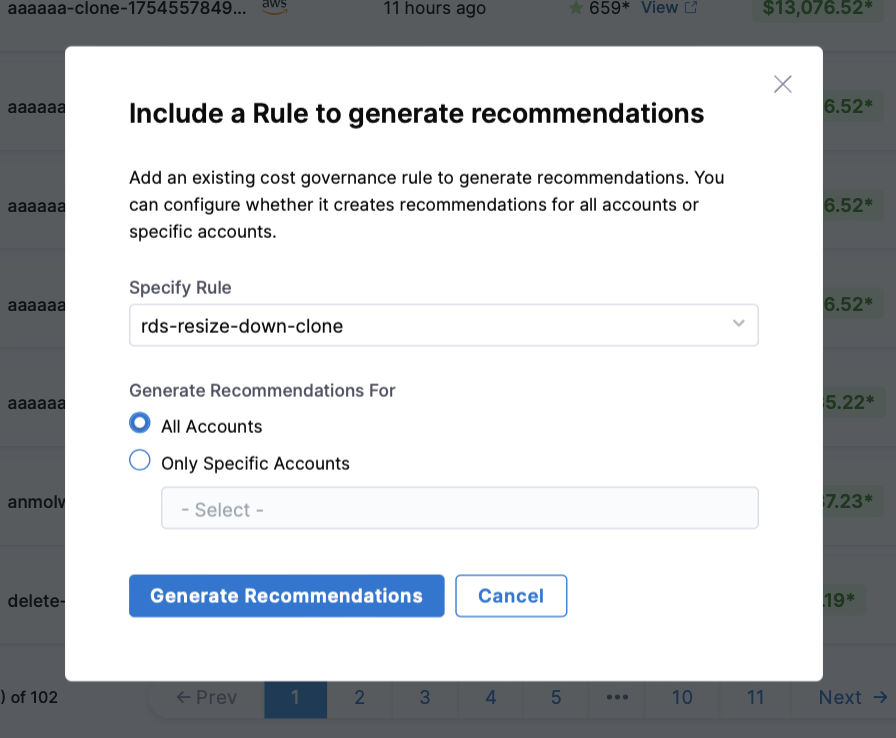
After this, all the rules generating recommendations can be seen in the Rules Generating Recommendations tab alongwith last evaluation, recommendations, potential savings and success rate. If any connector and region combination encounters an issue, the system flags it with a Failed status. The UI displays a detailed error message to assist in resolving the issue quickly.
Status Breakdown:
- Failed Status : A failed status indicates one of the following scenarios:
- Missing Permissions: The necessary permissions required for Harness to get or list resources are not provided.
- Harness Internal Error: A system-level issue occurred during processing.
- Ignored Status : An ignored status indicates one of the following scenarios:
- No Cost Data Available: Billing connector setup at Harness is missing cost data for the target cloud account.
- Cost Threshold Not Met: Cost is less than $300 for the GCP project.
- Invalid Region: The regions found in cost data is not valid to run against Governance Rule.
- Success Status : A successful status indicates one of the following scenarios:
- Recommendation Generated: The system successfully evaluated the rule and created a recommendation.
- No Resources in Evaluation: The rule was evaluated, but there were no resources found.
- Savings Below Threshold: A recommendation was generated, but the potential savings were calculated to be less than $10.
Granular Recommendations
Cloud Asset Governance provides valuable recommendations, but when it comes to operationalizing them at scale, it might become challenging. Additionally, when using shared cloud accounts across teams, project-level recommendations might not work out. With Granular Recommendations, Governance recommendations will now be generated at the individual resource level, ensuring greater granularity and actionable insights for both custom and out-of-the-box (OOTB) recommendations. This enhancement simplifies implementation and tracking, allowing customers to take more effective action on governance recommendations at scale.
Enabling Granular Recommendations
Owing to this, now, while adding a recommendation to Ignore List, users have the option to specify the scope at which the users want to ignore the recommendation. The scope can be either at:
- Rule-level
- Rule-level + Project-level
- Rule-level + Project-level + Resource-level.